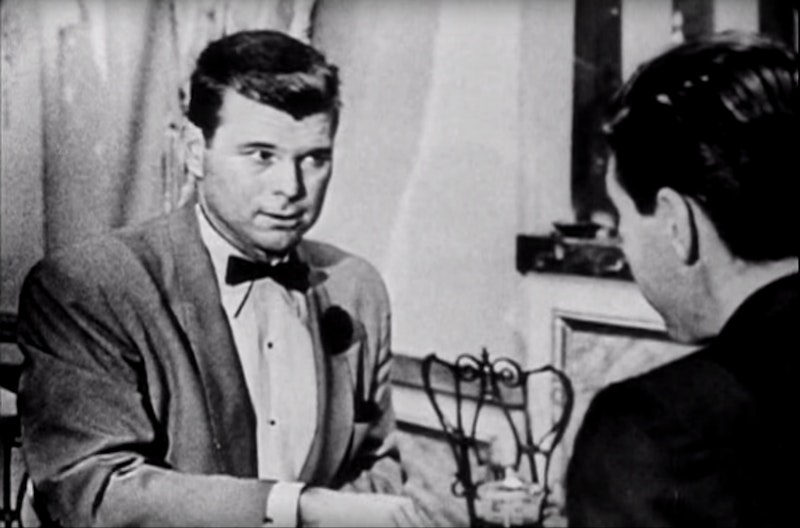It could’ve been any number of actors. It happened to be Barry Nelson. Nelson was a journeyman performer, born in 1917, who broke into film in his 20s with a small part in a Thin Man sequel. He did some stage work and went into TV in the so-called Golden Age. He'd have a part in a superior Twilight Zone episode, keep working in TV, and in 1980 played the manager of the Overlook Hotel who hired Jack Nicholson's character in Kubrick's The Shining. But before that, in 1954, he got a little piece of immortality. In a single hour of television, Nelson became the first James Bond on film.
Ian Fleming's Casino Royale was published in 1953 and went through three printings in four months in the UK. American sales were poor, but Fleming managed to sell CBS the rights to adapt the book for TV for $1000. In 1954 the book was turned into an hour-long episode of the anthology series Climax!, starring Nelson as the American Jimmy Bond of "Combined Intelligence," with Linda Christian as his love interest Vesper Mathis, and veteran Australian actor Michael Pate as Bond's British ally Clarence Leiter.
The story’s relatively faithful to the book: Bond—“Card sense Jimmy Bond, they call you,” Leiter recalls—turns up at the Casino Royale to clean out a Soviet agent named Le Chiffre in a high-stakes game of baccarat. The game, with its reversals and twists, is the story’s centrepiece. But what happens after is the emotional heart, as Bond must unravel the motives of Vesper and survive a confrontation with Le Chiffre.
Director William H. Brown didn't have much of a track record in TV, but one of the two writers who adapted the piece was Charles Bennett, a veteran who'd worked with Hitchcock. The other writer, Antony Ellis, was younger but would go on to a decent career in TV, creating episodes for shows like Gunsmoke and The Man from U.N.C.L.E.
The biggest name in the show was the man who played the bad guy. The first evildoer to cross paths with Bond was played by Peter Lorre, which in retrospect feels perfect: Lorre's got just the right mix of oily charisma and European cunning to be a classic Bond villain. At least, as we know Bond villains today; this was a very different Bond, but still Lorre could play the role of the gambling Soviet spy Le Chiffre in his sleep. Unfortunately, he very nearly does. He nevertheless has enough presence to carry the piece. And he has help. Pate as the nationality-swapped Leiter has a fascinating intensity and a conniving smile. Christian, as the first Bond girl on film, is convincingly elegant, tense and dramatic in what is a fairly standard role for a woman in a spy thriller.
And what of Barry Nelson? He plays what he's given: a 1950s agent of the American government, as imagined by a 1950s American TV production. He's straightforward, this Jimmy Bond, earnest, open and lackadaisical. He's not the Bond of either the book or the later films. Nelson plays what’s there in the script: a heroic law-enforcement officer. Mostly, he carries it off acceptably. But he’s out of his depth facing off with Lorre. I don’t see much chemistry with Christian either.
Tall, dark, and handsome, there's something Byronic about Bond as Fleming imagined him—not mad, but occasionally bad and dangerous to know. If not aristocratic he’s at least gentlemanly, and still capable and irresistible to women. That’s not the case here.
Visually, the show’s an episode of an anthology TV show from the 1950s. The casino set is reasonably effective, but a far cry from the rich settings of the films or from what Fleming imagined on the page. Hotel rooms are straightforward. There’s no distinctive visual identity, though it should be noted that the only surviving copy of the episode is a black-and-white kinescope of a show originally broadcast live in color.
There’s a stage-bound feel to the episode, the action slightly reshaped so that only a couple of locations are needed. It gets the job done, and the frequent close-ups so common to early TV give the show an identity. But it’s not very exciting to look at. It’s faithful to the book and does a good job of identifying what works and how the plot builds and releases tension. It changes the character of Bond, in the book dismissive of Vesper and women in general, repeatedly described as cold or brutal. The dialogue’s too stolid, hitting too many of the standard TV beats of the time.
There’s an urban legend that used to circulate about the show, which was lost between its original broadcast and the discovery of the kinescope in the early-1980s. Supposedly, after shot dead Lorre got up at the end and walked away, not realizing or caring that the cameras were on him. That doesn’t happen; there’s nothing so interesting here. This is a straightforward adaptation of a thriller that hadn’t made much of a splash in the United States. It’s a professional effort, but you wouldn’t think there was material here for one of the most profitable film franchises of all time. But Barry Nelson, dead now for more than 15 years, lives on as a black-and-white footnote to history.

